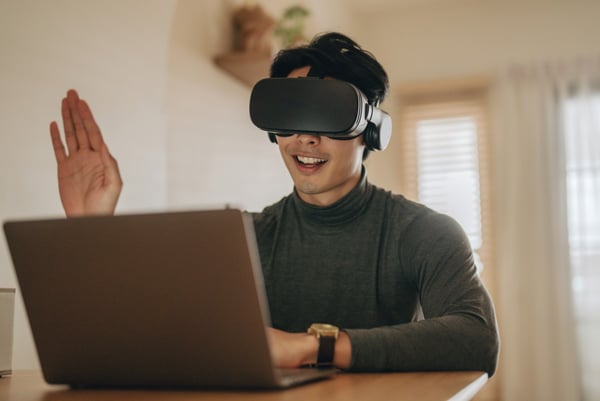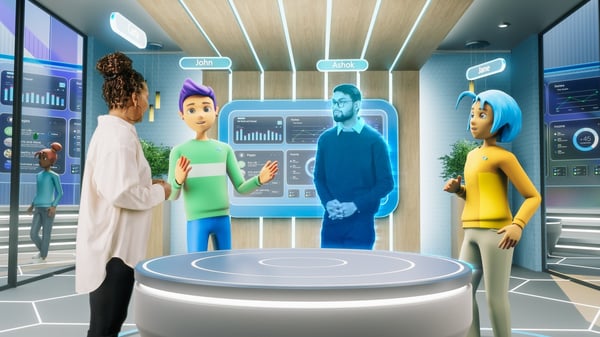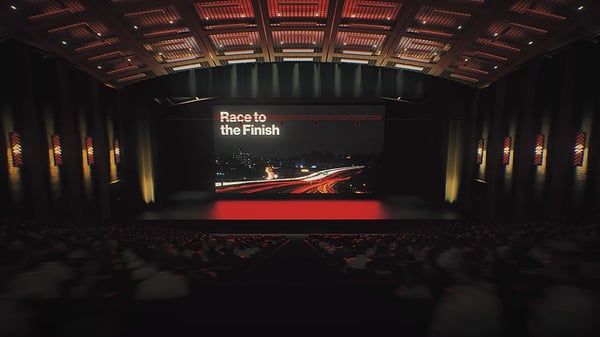 The metaverse has gone from science fiction to reality in our lifetime. While it still doesn’t quite look like what we see in the movies, it’s certainly evolving quickly. That means you should expect to see more immersive and virtual experiences at events. While consumer adoption will depend on accessibility and availability of virtual technology like VR headsets, the events industry may be one of the first places people gain exposure. However, this all depends on how we, as event professionals and planners, understand and leverage the technology to help create event experiences.
The metaverse has gone from science fiction to reality in our lifetime. While it still doesn’t quite look like what we see in the movies, it’s certainly evolving quickly. That means you should expect to see more immersive and virtual experiences at events. While consumer adoption will depend on accessibility and availability of virtual technology like VR headsets, the events industry may be one of the first places people gain exposure. However, this all depends on how we, as event professionals and planners, understand and leverage the technology to help create event experiences.
Quick Links
What Is the Metaverse?
We hope you weren’t expecting a simple answer. Even tech companies will tell you the metaverse is still in its infancy, so any clear definition will likely change as the technology evolves. In part, it’s a term for a collection of technologies that encompass a mix of both virtual and augmented reality. However, the metaverse does not yet require full immersion. The term is being used to describe virtual worlds experienced through video games, as well as headsets and more.
Those virtual worlds allow you to interact not only with other people, but they also allow you to participate in a virtual world economy and a variety of other virtual experiences. In short, the metaverse is an evolving concept of a singular virtual world that allows participants to fully immerse themselves in that experience. Currently, there is no technology that allows for a unified world. Instead, people can participate in iterations of a metaverse rather than the metaverse, and each of those iterations may be defined and developed differently with different levels of immersion.
What Is a Metaverse Event?
Given the understanding that a metaverse is a virtual space or world, metaverse events are any events that happen in a virtual world. But it doesn’t mean that there can’t be a live event happening simultaneously, whether that’s a virtual version of the live event or a virtual event happening concurrently.
This allows creators and metaverse event planners to be remarkably creative and to use the space in a variety of ways. That flexibility and freedom is incredibly appealing, particularly to generations that have grown up creating digital content while being actively involved in its consumption (we’re looking at you, Gen Z).
 Examples of Metaverse Events
Examples of Metaverse Events
Before the metaverse, the first virtual world was called Second Life. Second Life, for lack of a better description, is like a virtual world where you can create an avatar and a “life,” including a job, home, and friends. You can essentially create a “second life” in a virtual world where you’re unburdened by some of the challenges you may have in the real world. First introduced in 2003, Second Life obviously was the first to host metaverse events, ranging from house parties to concerts. It was also the first place that made others realize that virtual events and virtual reality could be leveraged to create fully immersive events and experiences.
The entertainment industry has been among the first to capitalize on metaverse events with concerts, but the gaming industry was not far behind. Gamers will recognize popular platforms like Roblox and Fortnite, not just for their gaming appeal (and events), but for their early investment in metaverse events. From the start, these games seemed to understand the communities they were creating in virtual worlds and the ways gamers and users were able to express themselves through their avatars.
These days, the metaverse and virtual spaces are being used for everything from webinars and networking events to fashion shows. NASDAQ has rung its opening bell in the metaverse and even Disneyland has said it plans on opening a virtual theme park in the metaverse in the coming years. In short, the metaverse isn’t going anywhere; it’s just getting started.
Tools Available to Create Live Events in the Metaverse
We’re still some time away from a VR headset in every home, though gamers seem to be adopting these technologies pretty quickly. So if you want to dabble in metaverse events and you’re not a gaming company, does that mean you need to wait? Not necessarily.
When it comes to the metaverse, as we mentioned, there’s no true definition yet, and that means you can start by leveraging some of the existing technologies to have attendees experience various levels of immersion. Some of those technologies exist already and are being used in the event space.
Those technologies are often referred to as the Metaverse of Things (MoT), much like the Internet of Things (IoT), which connects smaller technology with the digital world in a way that informs and improves real-world experiences. These technologies fall into two different categories: virtualization and immersion. Let’s take a quick look at both.
Virtualization
The difference between virtual and immersive technologies is that virtual tech keeps an individual rooted in the physical world. There’s still something separating them from the “metaverse” experience, such as a screen (a phone, laptop, tablet). However, experiences like this are still highly interactive.
In fact, companies are already making an impact in this space. For example, TouchCast prides itself on providing a way for consumers to interact with and “experience” a product (like a car) before they buy it, envisioning the features they want and getting a true feel. The individualization and personalization have immense value in both the retail and event space, especially because personalization continues to trend in our industry.
One way events are using virtual spaces is by creating a “digital twin.” A digital twin is a virtual space (or product) designed specifically to mirror a physical space (or object). In this way, virtual participants still get the look and feel of an in-person venue or event while participating virtually.
 Immersion
Immersion
Unlike virtualization, immersion seeks to make people feel like they are in a different world. It’s what most people think of when we start talking about the metaverse: a virtual world where we can actively participate and interact with our surroundings and essentially become “virtual” ourselves.
While some of these immersive experiences have workarounds, often they require the use of a VR headset. That, in itself, may create some limitations in terms of available tech.
Immersive technologies are already being used in video games that provide a first-person camera view. In this way, you see a scenario unfolding as if you are actually there. These are referred to as virtual scenarios and are already being used widely as learning tools.
Similarly, VR technology allows users to have a fully immersive experience, and when combined with digital twin technology, event attendees can truly feel as if they’re in the same venue or same space as in-person attendees.
The latest tech to hit the market and impact VR is OVR technology (essentially, olfactory virtual reality). Our sense of smell has the ability to immediately ground us in place or memory. It can trigger emotions and feelings and has the capacity to enhance virtual experiences because of this power. Imagine a VR experience where you are exploring a cave or a beach, and you can smell the earthiness, the water, and the salt. In terms of sensory experience, it makes the virtual realm that much more real.
Metaverse Virtual Events
While the metaverse has the potential to reshape in-person events with virtual experiences, some of this technology has significant potential for virtual events. Virtual events really took shape during the pandemic. The benefits are real, but the biggest challenge centers around being able to create an experience that mirrors the experience had by in-person attendees.
As we learned over the past few years, virtual spaces open up opportunities and help event planners and hosts overcome physical space challenges. Virtual spaces also provide the potential to be remarkably creative, so creative and tech teams are likely eager to see metaverse events become a reality.
Digital twins, virtual online spaces, and wider adoption of VR headsets mean all of this is coming sooner than we think, especially as virtualization takes hold in retail spaces and consumers become more familiar with the technology.
 Are You Prepared? Metaverse Event Planning for the Future
Are You Prepared? Metaverse Event Planning for the Future
We know it’s coming. We know it involves new technology and some learning curves. We know it will revolutionize many industries, including the event industry. So how do we best prepare for the arrival of metaverse events?
1. Understand your technological strengths and weaknesses, and choose tech wisely
As an event planner, there’s no doubt that metaverse events will require a keen understanding of not only the technology necessary, but also the tech expertise you’ll need to create, produce, and support an event that relies so heavily on tech.
Similarly, you want to make sure you’re utilizing technology that is accessible and available to your attendees. You want to avoid creating technological hurdles for attendees, especially if the virtual space isn’t the right fit for your audience. Ensure that the metaverse helps to meet the goals of your event.
2. Remember, it’s still an event
Though technology is the vehicle through which you’ll deliver aspects of the event, it’s easy to get bogged down by technological needs and go down the proverbial rabbit hole that is virtual space and virtual reality. But an event is still an event. You want a goal, a mission, and a cohesive feeling. Any metaverse aspects should enhance that – otherwise you risk it just being superfluous technology that doesn’t impact overall event experience.
3. Be creative (and fun!)
One of the most amazing aspects of metaverse events is that we’re not limited by physical realities. We can create spaces and experiences that are extraordinary. Space designers have a blank canvas, and while digital twins may be your best bet for some events, it’s still an opportunity to be creative and have fun. Virtual trade shows and exhibition halls present various opportunities to tap into.
4. Keep your guests in the loop
We’re not just talking about marketing here. If you think the metaverse is new to you, some of your attendees may be even less familiar with the concept – let alone the technology they’ll need to participate. Consider creating collateral that will help educate guests and put them at ease when using the technology. Explain the advantages and use your marketing to get them excited about the experience.
5. Create space and give time for casual connection
As the host, planning and including space for connection will be vital, and the metaverse provides unique opportunities for your attendees to connect. Be sure to include networking time for your audience in order to get the most out of your virtual event.
The final tip? Find the right partner. In capable hands, a metaverse event has amazing potential to catapult you to the top of your guests’ most memorable event list. That means finding an event planning partner who has the technological expertise and the planning experience to view your metaverse event holistically.
If you’re ready to explore how technology can transform your corporate event, get in touch with the Bishop-McCann team today. The space we create may be virtual, but the JOY will be real!
